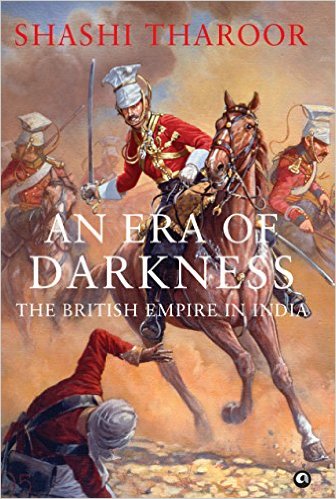An Era of Darkness Summary
7 min read ⌚
 The History of the British Empire in India
The History of the British Empire in India
There are literally hundreds if not thousands of unanswered questions, regarding the Indo-British history.
Having the undistorted reality served on a silver platter is not a realistic scenario, due to an overload of false and forged documents.
Without further delay, find out what happened in the age of territorial expansion of the British Empire.
Who Should Read “An Era of Darkness”? And Why?
Well, it’s not just India, but the world has always been prone to violence and territorial expansionism. The battle for interest is a part of our subconscious mind, and many Empires such as the British one, took things too far by fully depriving the conquered people of its belongings and rights.
“An Era of Darkness” reveals the horrors and atrocities committed by the British invaders, and how they managed to crush India from within.
About Shashi Tharoor
 Shashi Tharoor is the author of many bestsellers, diplomat, and a politician who strives to preserve India’s authority by expressing the details.
Shashi Tharoor is the author of many bestsellers, diplomat, and a politician who strives to preserve India’s authority by expressing the details.
He has been featured in multiple magazines worldwide, and as a speaker tries to tell the real story behind India’s lack of functionality. Shashi is also a member of the parliament.
“An Era of Darkness PDF Summary”
The British rule in India was followed by a series of bloody events and plunders. Indeed, India was an agricultural and industrially backward nation at the time. The British mainly used this as an incentive to subdue any urge for sovereignty, and thus, exportation of resources took place.
For over two centuries of exploitation and embezzlement, the once mighty Indian Empire was on the brink of collapse due to famine and poverty in large scales.
Nowadays, we bear witness to many Britishers who claim that India without its “Parent” nation would not have become the country it’s today. On the other end, Shashi Tharoor strongly rejects this notion and states that India was basically robbed and stripped of its resources during the British reign. No good came out of it!
The Beginning of the End
The plight of many Indians is not a topic to be so easily scanned through. For people of the outside world, in the 18th century, India was a “free marketplace” for the British who needed labor, jewelry, silk, valuable metals, you name it.
For those that don’t know, India participated in the world trading community with an astonishing 23% in the 18th century – making it the world’s most material rich nation. Nonetheless, the British conquest, backed by larger and superior British Force managed to defeat and overthrow Indian rulers who fought for self-government and freedom.
A throwback to an era before the British rose to power – tired of the ruling elite of the Mughal Empire, many provinces of India stepped aside and formed their own alliances. The British East India Company took advantage of the political instability at the time, and slowly one by one managed to conquer all regions through bribery, treachery, and mostly threat.
Deindustrialization to accentuate British Dominance
The key to capitalist success was to weaken the Indian economy by placing restrictions on the industries that flourished. Prior to British reign, Indian textiles and other goods were in high demand throughout the world.
As it turns out, India was crushed and became an importer from Britain, instead of exporter with many things to offer on the global market. At the expense of their own industries, India fueled the soar of the British Economy and helped them to establish superiority, on a worldwide scale.
Shipping and Shipbuilding Industrial Breakdown
East India Corporation strived to gain a monopoly over trading and thus impose its will overseas. In order to do just that, seizing control over the long coastline was a priority. The trade relations between Indians and other nearby nations, suddenly vanished when the British destroyed their ships and sank the Shipbuilding Industry by the 1850s.
For those that still wanted to export goods through the Bay of Bengal, the British dictated tariffs that were impossible to meet. The need for more ships shattered, as the British wrest control over all industries and presented its hegemony over the subdued Indian Nation.
The deep economic malaise brought India to its knees, as nothing more than a poor and industrially weakened nation.
Opinions differ on United India
Most westerners believe that Indian clans, regions, or provincial kingdoms were united thanks to Britain. What comes as a surprise to these figures is that India always considered itself to be one state, with extended reach throughout Asia.
Generally speaking, British rule was just one big robbery, perfectly orchestrated and perceived through the lens of industrial advancement, which never came. The bureaucracy imposed on various regions with total disregard of the people’s cultural system made many people landless peasants, on the verge of extinction.
Farmers who previously worked their lands to make a living were banished from their shelters and forced into collectivized poorness.
Free Press, sort of
Many misconceptions and misinterpretations flow regarding the British introduction of “Free Press.” As we all know, mainstream media is a great way to influence the masses, and as a result, the East India Corporation enacted a law in 1799, to gain full control over the information distributed to the people.
The Media appeared free, but many journalists and editors were jailed for criticizing the state. They were labeled as aggressive newspapers, which didn’t comply with the counts presented in the act.
The British realized that the press could constitute a threat to their rule, and slowly started to suppress its influence. The first and primary target was the local newspapers which had to put up considerable deposits to continue their work.
On the other end, the imperialistic media was free to continue the publishing process, and support the regime.
British Contribution to Starvation and Illiteracy
Although Britain will never publicly admit the atrocities committed during their reign, it’s estimated that over 30 million people died as a direct result of bad policies. What’s even worse, these crimes were actually avertible, and according to many Indians, this orchestrated disaster deserves to be perceived as the “Untold” Holocaust.
If the British authorities provided aid to the victims of the famine, the entire Indian population would’ve demanded the same treatment. Therefore, they wisely choose not to take part in such activities and deprived the Indians of everyday necessities.
In 1943, the British “launched” their last drought also known as the Bengal Famine. By stocking up on supplies for the war campaign, they planned to support their troops in Europe. In addition, the British rejected American and Canadian aid and did nothing to help the victims.
When it comes to education, India has a long history of success in mathematics, science, architecture and other branches. The British rulers didn’t modernize the Indian educational system, as many like to believe. They even induced informational stagnation to strengthen their grip on power.
There were a lot of Universities thrown up all around the country in Vikramashila, Nalanda, Somapura Mahavihara, Odantapuri, which matched the European education centers in all regards.
The teacher to student learning method was also highly popular among Indians, regardless of the cultural diversity in the country. Even those that managed to push their way through the obstacles were cast aside by the system and positioned in the lower tiers of Indo-British society.
Key Lessons from “An Era of Darkness”
1. The Positive Sides of British Rule
2. GDP Collapse
3. Aftershocks of India
The Positive Sides of British Rule
It’s not easy to draw positives from this bloody reign, but the British introduced railways and modernized the Indian Army.
Truthfully, they did all that for their personal benefits, but it’s something that prompted progression.
GDP Collapse
When the British came to power, India was a force to be reckoned with on the worldly arena – 23% of the world GDP, speaks for itself.
In 1949, that number plummeted to just 3%, and it unveiled the facade behind the two-century reign of Britain.
Aftershocks of India
Martin Luther King impressed by Gandhi and his peaceful protest against the British rule, marked the beginning of a liberation era.
Many other similar uprisings broke out with a single intention in mind, to confront the oppressors.
Like this summary? We’d Like to invite you to download our free 12 min app, for more amazing summaries and audiobooks.
“An Era of Darkness Quotes”
I do not look to history to absolve my country of the need to do things right today. Rather I seek to understand the wrongs of yesterday, both to grasp what has brought us to our present reality and to understand the past for itself. The… Share on X History, in any case, cannot be reduced to some sort of game of comparing misdeeds in different eras; each period must be judged in itself and for its own successes and transgressions. Share on X Indians paid, in other words, for the privilege of being conquered by the British. Share on X When we kill people, we feel compelled to pretend that it is for some higher cause. It is this pretence of virtue, I promise you, that will never be forgiven by history. Share on X India is my country, and in that sense my outrage is personal. But I seek nothing from history—only an account of itself. Share on XOur Critical Review
It’s needless to say that the British did nothing to improve the lives of millions of Indians who lived poor and wretched life.
The end of colonization and apartheid was a shred of hope for the conquered people to start rebuilding their state and society. It goes on to this day.
Emir is the Head of Marketing at 12min. In his spare time, he loves to meditate and play soccer.


 The History of the British Empire in India
The History of the British Empire in India




